Solid Oxide Fuel Cell Manufacturing
Solid Oxide Fuel Cell manufacturing is a complex and multi-step process involving a sophisticated combination of multiple materials and technologies. The following is a detailed overview of the SOFC manufacturing process:
1. Material Selection and Preparation
- Electrolyte Materials: The electrolyte is the core component of SOFC and is generally made of oxide ceramics, such as yttria-stabilized zirconium oxide (YSZ). These materials have excellent ionic conductivity at high temperatures.
- Anode Materials: Anode materials require high electronic conductivity, stability in a reducing atmosphere and good permeability. Common anode materials include nickel-based composites such as Ni-YSZ.
- Cathode Materials: Cathode materials should have high conductivity, high-temperature oxidation resistance and thermal stability, such as doped oxide ceramics such as LaMnO3 or La1-xSrxMnO3.
- Connector Materials: Connector materials are used to connect single cells in series or in parallel into battery packs, and are required to have good electronic conductivity and stability at high temperatures. Commonly used connector materials include lanthanum chromate (LaCrO3) or high-temperature alloy materials with a perovskite structure.
- Other materials: including sealing materials, gas transport channel materials, current collection terminals, sensors, and heat control devices.
2. Manufacturing process steps
Powder preparation: Prepare powders of electrolyte, anode, cathode and other materials by chemical synthesis or physical methods (such as ball milling).
Molding and sintering:
- Molding: The powder is made into a green body of the desired shape by dry pressing, isostatic pressing or slip casting.
- Sintering: The green body is sintered at high temperature to partially fuse the particles to form a dense and stable ceramic structure. The sintering temperature is usually between 1300-1600°C, depending on the material composition and the required performance.
Electrode coating: Anode and cathode materials are coated on both sides of the electrolyte to form an electrochemically active layer. Coating methods include screen printing, spraying and electrochemical deposition.
Connector and sealing: Use connector materials to connect single cells in series or in parallel into a battery pack, and use sealing materials to connect the electrolyte and connector together. The sealing material is required to be resistant to high temperatures and have good airtightness.
Assembly and testing: Assemble the single cell or battery pack with the fuel reformer, gas delivery channel, current collection terminal and other components to form a complete SOFC system. Then perform performance tests, including open circuit voltage, output power density, fuel utilization and other indicators.
3. Quality control and optimization
- Physical property detection: Including the detection of indicators such as size, density, porosity, flatness, etc., to ensure that each component meets the design requirements.
- Chemical property analysis: Analyze the phase composition and microstructure of the material by methods such as X-ray diffraction (XRD) and scanning electron microscopy (SEM).
- Electrochemical performance test: Test the output voltage, current density and other electrochemical performance parameters of the battery under simulated working conditions.
- Process optimization: Optimize and adjust the manufacturing process according to the test results, such as adjusting the sintering temperature and time, improving the electrode coating process, etc., to improve battery performance and reduce costs.
4. Technical difficulties and challenges
- Material stability: Maintaining the chemical stability and thermal stability of the material at high temperature is a huge challenge.
- Sealing: Ensure a good seal between the electrolyte and the connector to prevent gas penetration and mixing.
- Thermal management: SOFC works at high temperatures and requires effective thermal management measures to maintain the stability and uniformity of the battery temperature.
- Cost reduction: At present, the cost of SOFC is still high, and further research and development of low-cost materials and manufacturing processes are needed to reduce costs and improve market competitiveness.
In summary, SOFC manufacturing is a highly complex and multidisciplinary process. With the continuous advancement of technology and the reduction of costs, SOFC is expected to play a more important role in the future energy field.
Ultrasonic spray fuel cell catalyst coating system can produce highly uniform, repeatable and durable coatings. Our ultrasonic spraying can well control coating properties, significantly reduce material usage, and reduce maintenance and downtime.
Our company’s ultrasonic spraying equipment can be sprayed on a variety of different metal alloys, including the preparation of platinum, nickel, iridium and ruthenium-based fuel cell catalyst coatings, as well as PEMs, GDLs, DMFCs (direct methanol fuel cells) and SOFCs (solid Oxide fuel cell) manufacturing. The battery manufactured by this technology has the characteristics of high battery load and high battery efficiency.
The optional ultrasonic dispersion system can uniformly disperse the catalyst solution without blocking the ultrasonic nozzle, thereby providing a uniform and homogeneous fuel cell catalyst coating, and has a controlled droplet size from ultra-low flow to production-scale flow.
About Cheersonic
Cheersonic is the leading developer and manufacturer of ultrasonic coating systems for applying precise, thin film coatings to protect, strengthen or smooth surfaces on parts and components for the microelectronics/electronics, alternative energy, medical and industrial markets, including specialized glass applications in construction and automotive.
Our coating solutions are environmentally-friendly, efficient and highly reliable, and enable dramatic reductions in overspray, savings in raw material, water and energy usage and provide improved process repeatability, transfer efficiency, high uniformity and reduced emissions.
Chinese Website: Cheersonic Provides Professional Coating Solutions


